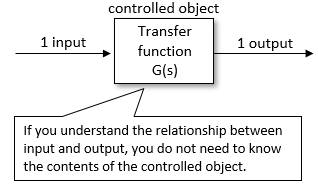Difference between modern control and classical control |
|||||||||||
・RC Circuit
|
・In Japanese
PID control, which is one of the classical controls, is explained here. The purpose of both classical control and modern control is the same: to make the object to be controlled move as desired.
Since the method of controlling the object is different, I will explain how it differs specifically. ■Features of classical control
First, let us review classical control.
Classical control solves the differential equation of the controlled object and expresses it as a transfer function.
A transfer function is a function that has one output for one input.
Classical control theory pursues how to find the optimal input value in order to set the output to the target value. <Advantages and disadvantages of classical control>
Classical control has the advantage of easy control design and tuning because it is sufficient to know the relationship between the input and the output without knowing the contents of the object to be controlled (even without solving differential equations).
On the other hand, it has the disadvantage of not being able to design control parameters that are theoretically optimal.
Some experience in tuning is required.
■Features of modern control
Modern control is concerned with the internal state of the controlled object, in contrast to classical control, which only requires understanding the relationship between the input and output of the controlled object.
Classical control is the same as solving differential equations, but modern control is expressed by state equations after that.
The state equation neatly describes the internal state and defines the relationship between inputs and outputs.
And it is possible to support multiple inputs and multiple outputs instead of just one input and output. <Advantages and disadvantages of modern control>
Modern control makes it possible to set a mathematically correct feedback gain by accurately representing the internal state of the controlled object.
Also, since it can be expressed as a first-order differential equation using state variables, it is a great advantage that even difficult differential equations can be handled.
On the other hand, the disadvantages are that it is necessary to correctly express the internal state (skill to create differential equations is required) and that the effect of feedback gain cannot be intuitively understood.
Even if you want to fix the gain a little, it is difficult.
|
|
|||||||||

